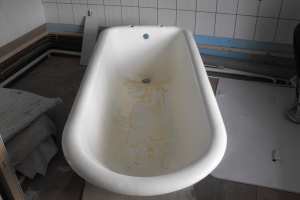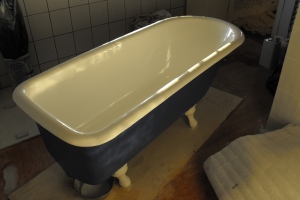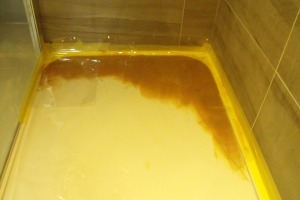MAKING TAP HOLES DISAPPEAR!
- At May 27, 2011
- By
- In bath resurfacing
Filling of Tap Holes
In Victorian Roll Top Bath.
On the 9th of May, 2011 we went to a job in Newbury, Berkshire.
The client wanted the tap holes on her Victorian roll top bath filled and then the whole bath to be resurfaced.
The tap holes themselves were on the “roll” itself and were cut into the curve of the bath.
(This was why the client wanted them filled as they were only able to find taps with flat bases and as a result the taps wouldn’t fit flush to the curve of the roll top on the bath.)
So they’d had their plumber install taps on a stand so now the new taps wouldn’t be on the bath at all.
But this left two, newly redundant, tap holes, which is where we came in.
The bath had been resurfaced by another company at some point in the past. This was now failing. Before we could start on the tap holes and get the bath resurfaced with our advanced system, we would need to strip this old failing surface off
Once that had been dealt with, fibreglass was applied to the tap holes to give the area strength. Once this had hardened, smoother fillers were used to help form the curve needed.
When the filled holes had been shaped to match the adjacent area of the roll top, the entire bath was resurfaced.
And then it was a case of, at least for the tap holes, now you see them, now you don’t
If you would like your bath resurfaced by The Bath Business and perhaps also have some tap holes filled the visit us at https://www.thebathbusiness.co.uk
SHOWER TRAY SLOPPING
- At May 26, 2011
- By
- In bath resurfacing
Slopping Shower Tray.
This is a shower tray we worked on in the village of Otford, which is near Sevenoaks in Kent.
The tray had been fitted quite recently and had seemed to be fine to begin with. However, the middle part of the tray had started to bow up, preventing the water from draining at the far end of the shower tray.
As the tray had already been set in place and tiled around, replacing it presented some difficulties. And also a considerable expense.
We were asked by the owner if we could build up the area where the water sat so that it would drain.
The work was more that could be done in a day as the plan was to use fibreglass to build up the low area and then resurface the whole lot. But the fibreglass needed time to dry and there would be quite a lot of work in getting the whole lot smoothed down enough so the fibreglass blended seamlessly with the existing surface.
The first part of the job involved mapping out on the shower tray where the water was sitting and not draining. Here is a picture.
Then fibreglass was applied, dried and sanded so that it was smooth but also had a fall on it.
As the water that didn’t drain was over a centimetre deep in places, this meant that the shower tray ended up being built up higher than the existing top edge of the tray, so towards the back of the shower the shoulders disappear.
After this had all been dried and smoothed, the area was primed and then the whole thing was resurfaced. Then I went back once this had dried and gave it the “Rolls-Royce” treatment and sanded and polished the shower tray to a lovely smooth finish.
BETTE BATH SLIP-UP!
- At May 25, 2011
- By
- In bath resurfacing
Bette Bath Slip-up!
In Nov 2010, we received a call from Garry McDonald, a plumber in Edinburgh, Scotland.
He was working on a property in the village of Gullane . Gullane is situated just down the coast from Edinburgh and is a well-known golfing area.
The property was near completion and it would then be a luxury short-let for people wishing to come to Gullane on golfing breaks.
Two baths had been ordered from Bette in Germany, one in the shape of a letter “p”, the other a “q”. Bette Baths can be supplied with a non slip or anti slip surface on part of the base of the bath. The baths should have been specified as being non-slip, but this was overlooked on the order.
When the baths arrived at Gullane, it was realized they were not non-slip. And as it was going to be a rental property, there was no way these baths could be fitted due to health and safety requirements.
Garry went back to Bette to see about getting two more baths sent, but non-slip this time. Unfortunately it would take at least 3 weeks to get the baths made and sent over to him – much too long!
Next he tried Bath resurfacing companies, bath repair companies etc around him who could apply a non-slip surface to the Bette baths he had. He didn’t have any luck there at all. No one in Scotland or England seemed to be able to do the job for him.
Eventually he called us. We said we could help and could do the work in our workshop at which point Garry breathed a huge sigh of relief. Our workshop is in South East England. Ideal for London-based company’s or individuals based in the South East. A bit of a trip for Garry though. We did have a courier company who could bring the baths down to our workshop so we set about organizing this for Garry.
But due to how close the house was to completion the courier company couldn’t get the baths down and back quickly enough for Garry to ensure he completed on time for his client.
In the end Garry himself drove the baths down in his van!
He drove down, stayed in a hotel close by and delivered the baths to the workshop in the morning. Then he drove to Gatwick, parked the van up and flew back to Scotland.
We were quite impressed at the lengths Garry was willing to go to to get the job done and done correctly for his client.
The work was done on the baths, taking the non-slip coating up the side of the bath by an inch, as specified by Garry.
Once the baths were finished, Garry flew down, got his van and picked up the baths and drove back to Gullane with them.
He still didn’t know at this point whether the Architect on the job would accept the baths or not, and the architect may have demanded that the baths would only be acceptable with a finish applied by the manufacturer. So then Garry would have went to quite a lot of expense and it might still have been a complete waste of time and effort and money.
After a couple of weeks we gave Garry a call to see how things had gone.
It turned out the architect had been more than happy with the non-slip finish. The architect thought the baths looked even better the originals Bette supplied would have looked! The baths had been installed! The Job was completed by Garry and the house got its first guests!
You can visit Garry at www.gpmcdonaldplumbingandheating.co.uk.
NEEDLE SHOWERS- YOU’LL GET THE POINT!
- At May 19, 2011
- By
- In bath resurfacing / Shower / Victorian Bathroom
Unlike nowadays where a thermostatic shower is considered the norm rather than a luxury it was not common for a house that was built prior to 1920 to have a shower installed. At the time this would have been quite a hefty additional expense. Indoor plumbing was still somewhat of a luxury for many sectors of our society.Even where indoor plumbing was common, such as the big cities, showers were used primarily by men, and not women. Hard to believe though it is the streams of water were widely felt to be harmful to women. A woman was definitely the weaker sex in Victorian and Edwardian Britain. If a woman did want to shower it was recommended she take the advice of her physician.
So, well up until the 1930s, most women would not consider showering. What need was there for a shower fixture in the home? Bathing was done in the bathtub. But showers were used in the home for medicinal or therapeutic purposes. Shower sprays were believed to stimulate the action of the skin, and make some people healthier. Even today many modern advertisements for showers or showering products promote the invigorating feelings produced by having a shower. Power showers are a must and a luxury shower with additional jets is even better.
But, there were some people who specified showers be installed in their pre-1920 homes, and those people tended to be wealthy. Very Wealthy. The showers that had the most therapeutic value were the ones that had multiple sprays that would apply jets of water to specific parts of the body. These showers were called needle showers, since the fine jets of spray would strike the kidney area, ribcage, liver or spine like fine needles. These elaborate showers were very expensive, commonly costing from 10 to 15 times more than installing a very good standard complete bathroom. So in todays standards if you spent a relatively modest £5000 kiting out your new bathroom your needle shower would cost you a staggering £50,000 minimum. And you can buy reproductions today ranging in price from £9000 to £20,000. Perhaps not quite as expensive in comparison but certainly a luxury item.
This might help explain the rarity of antique showers today, especially the ribcage or needle showers. They were mainly only found in a very few affluent homes. And owners of such homes also were more likely to upgrade and modernize their homes on a fairly regular basis. Brass has always been a highly sought after commodity, so these showers did not tend to hang around once removed from their original installation. They were scrapped out for brass, and lost forever. Such a shame. So finding an original is rare indeed.
Today there are a few company’s that reproduce Needle showers and they are still sought after luxury items.















 Add us to your circle
Add us to your circle